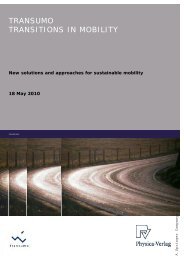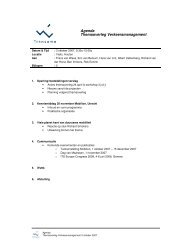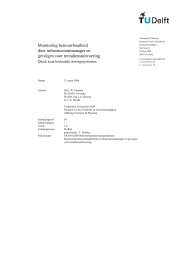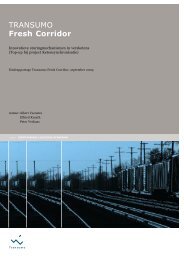Casestudie Breakdown prediction Contell PILOT - Transumo
Casestudie Breakdown prediction Contell PILOT - Transumo
Casestudie Breakdown prediction Contell PILOT - Transumo
You also want an ePaper? Increase the reach of your titles
YUMPU automatically turns print PDFs into web optimized ePapers that Google loves.
pictured in Formula 5-12. Beside a change in state it is also possible that the state<br />
remains the same for another time interval. This probability is given by<br />
each column. ([Beichelt97], p. 146)<br />
p<br />
ii<br />
within<br />
⎛ p<br />
⎜<br />
⎜ p<br />
P = ⎜<br />
⎜ M<br />
⎜<br />
⎝ p<br />
00<br />
10<br />
i0<br />
p<br />
p<br />
M<br />
p<br />
01<br />
11<br />
i1<br />
L p<br />
L p<br />
L M<br />
L p<br />
0 j<br />
1 j<br />
ij<br />
⎞<br />
⎟<br />
⎟<br />
⎟<br />
⎟<br />
⎟<br />
⎠<br />
Formula 5-12: Transition Probability Matrix<br />
As every<br />
p represents a probability, they all have to comply with 0 ≤ p ≤1.<br />
ij<br />
Moreover, every state must have a succeeding state. Hence, the probability to take<br />
one of the available countable states as the next one has to be one hundred percent.<br />
This leads to the conditions pictured in Formula 5-13 for the transition probability<br />
matrix. ([Jondral02], p. 186-187)<br />
ij<br />
0 ≤<br />
p<br />
ij<br />
≤1<br />
∀i,<br />
j<br />
and<br />
N<br />
∑<br />
j=<br />
1<br />
p<br />
ij<br />
= 1<br />
∀i<br />
Formula 5-13: Conditions for the Transition Probability Matrix<br />
As the sum of every row within that Matrix has to be 1, p = 0 entries can be left out<br />
to offer a better overview. To achieve an even better overview, Markov chains are<br />
often visualized as a graph. Every node of that graph represents a possible state and<br />
every arrow a possible transition with a positive probability. ([Waldmann04], p. 17)<br />
ij<br />
A Markov chain can be used, for instance, to describe the following gamble between<br />
two people: A coin is thrown. Depending on which side is faced up, one of the two<br />
players wins the coin. Player one starts with four coins, player two with two coins.<br />
The game ends as soon as one of the players owns all six coins. This leads to seven<br />
possible states because a player can own every number of coins between zero and<br />
six. Provided that every coin has the same winning probability p the transition<br />
probability matrix would look like the one pictured in Formula 5-14. As described<br />
above, this Markov chain can be visualized as a graph to allow a better overview of<br />
the described process. A comparison of Formula 5-14 and the corresponding Figure<br />
5-5 shows this improvement. 53<br />
53 Example taken from ([Waldmann04], Chapter 2)<br />
69
















